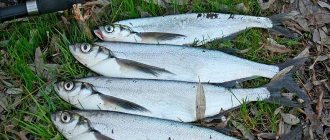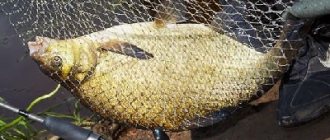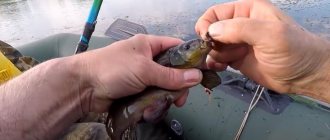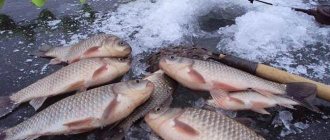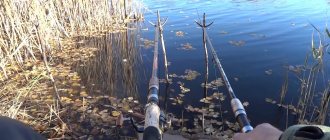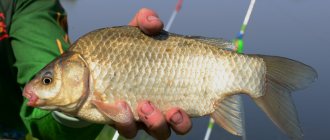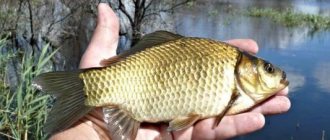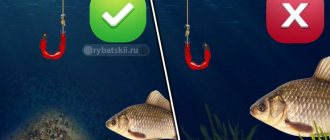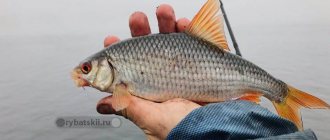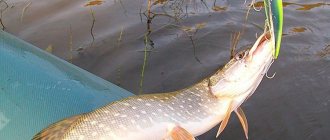For some anglers, catching crucian carp on a feeder is a stumbling block. It turns out to catch bream, silver bream, roach, small crucian carp, but not a silver glutton weighing under a kilogram. The point is a special tactical approach, which differs in some respects from the standard feeder practice of creating a feeding spot and fishing on it.
Fishing for crucian carp, except for the periods of feeding in May, when it goes for everything, requires the angler to have a special feeding and fishing technique. In this article we will look at how to catch crucian carp on a feeder correctly, what gear, bait and bait to use for this.
Fishing for crucian carp
- The capriciousness of crucian carp is known. At different times, this fish changes its diet. The choice of groundbait, lures, feeder fishing tactics and equipment handling techniques is influenced by a lot of factors. Despite being omnivorous and resistant to negative environmental factors, crucian carp are not always hooked by fishermen.
- Catching crucian carp with a feeder is no exception. To always catch this fish, you need to study the habits and behavioral characteristics depending on the season. Then feeder fishing for crucian carp will grow from accidental success into systematic fishing.
- Crucian carp is omnivorous, feeding on bottom living creatures, plant components and even fry. This fish survives even in frozen ponds if there is silt at the bottom, in which you can bury yourself until spring. In the southern regions, silver crucian carp (hybrid, dushman) is also caught from under the ice in winter.
- There are very few golden crucian carp left in our reservoirs - they have been replaced by rotan and their Far Eastern silver counterpart. Now the hybrid has filled not only ponds, but also rivers and reservoirs, and continues to spread even more, displacing other fish. On the Don and to the south it is already much easier to catch large crucian carp in a reservoir, rather than carp or bream. Hybrids up to 1.5 kg are normal in these areas.
- In the middle zone, silver is smaller, up to 500 grams, but is also present in rivers and ponds. Only in northern cold waters there is none or very little of it.
Read more about fishing for crucian carp.
Catching crucian carp in May with a float rod
Most often, crucian carp are caught using a float rod in May.
This month crucian carp is caught at some distance from the shore, so fishermen choose a long rod - from 4 to 6 meters. The rod should be as light as possible so that it is possible to cast the bait into the water quietly, because crucian carp are shy in the pre-spawning period, and excess noise will scare them away from the feeding area. If the fishing rod is equipped with a reel for long-distance casting of bait, then it is permissible to use a rod of shorter length. Read also: How to equip a float rod for catching crucian carp
Some information about what types of float rods there are:
- flywheel - there are no rings or reels on it, the fishing line is attached to the tip of the rod, the casting range corresponds approximately to the sum of the lengths of the blank and the fishing line;
- match - equipped with a large number of rings, there is a place to attach a reel, this rod is used by professionals and sports fishermen;
- Bolognese - the most popular fishing rod among amateur fishermen, equipped with a number of rings and a reel seat;
- plug-in - the rod consists of several parts that are connected to each other using connecting tubes; without certain skills, it is not easy to use.
This is interesting: Fishing for crucian carp with a sliding float
May crucian carp is shy, so the fishing rod is equipped with a thin fishing line - from 0.12 millimeters to 0.18 millimeters. Light floats weighing up to a gram are placed on the fly and plug fishing rods. Goose feather type floats have proven themselves well; they are very sensitive to the slightest bite.
Match fishing rods are equipped with floats weighing approximately 12-15 grams; for a Bolognese fishing rod, a float weighing from 3 to 5 grams is sufficient. The floats are surrounded by lead weights in the form of pellets. Their weight depends on the buoyancy of the float: a gooseneck float requires a small shot, a float weighing 15 grams must have a heavier weight.
The process of equipping the fishing rod is completed with a hook - it is advisable to use a high-quality and very sharp product from well-known companies, No. 10-14 according to the international classification, or No. 3-5 according to the domestic numbering.
Where to look for crucian carp with a feeder
Fishing for crucian carp with a feeder is possible in any reservoirs in which this fish is present or comes to spawn in the spring. Catching the silver glutton is multifaceted - depending on the season and conditions of the reservoir, you can catch it with a feeder in deep holes from the edge, in coastal grass, and in a fast stream, where a 140-gram feeder can hardly stand.
There are situations when crucian carp are caught on everything and everyone - this happens in the spring, when migratory schools enter rivers and floods to spawn. At this time, in such places in the south they catch in bags. The rest of the time, in each specific body of water, you need to find an approach to this fish.
The versatility and adaptive ability of this fish plays a cruel joke on the fisherman - in each new body of water it has its own preferences. Moreover, they can differ radically from those familiar in another body of water. In addition, the tastes of silver are inconsistent - today it tastes like a worm, and tomorrow it tastes like one pearl barley with a garlicky smell.
Individual flocks in the same body of water also behave differently. And if an angler catches several in a row, this does not mean that this will continue all day. The key to this particular flock that has just approached has just been found.
Rivers
It is difficult to find crucian carp in large rivers if you do not know specific points operating at this time. Therefore, before fishing with a feeder, you need to make inquiries with local fishermen. The silvery fastidious fish can walk along the pit, under the edges, rising at night closer to the bushes on the shore. Elsewhere it may be found in shallow bays with soft bottoms and abundant vegetation.
There is crucian carp in every section of the reservoir - you just need to find and pick up the keys. You need to check with a feeder all places that are promising for catching any fish - edges, irregularities on the bottom, areas with snags, slopes and shells, entrances and exits from holes, the boundary of a calm and fast (reverse) current, shallow overgrown bays.
Catching crucian carp with a feeder in small rivers is easier from a search point of view. If the river is the same in relief, straight, with a trough bed and overgrown banks, we check two options. This is a drop into the riverbed and an area under the opposite overgrown bank. Moreover, at different times of the day the flock walks along certain routes. It is likely that at night it comes out of the riverbed towards the coastal vegetation to feed. On a monotonous bottom it is easier to attract bait. In rivers with varied terrain, the list of possible fishing spots expands, and here, first of all, you need to rely on finding a place, and not feeding:
- Bays with water lilies and depths of 0.5-3 meters.
- Small, long, silty tongues of water protruding into the shore, completely overgrown with reeds or mud - you can fish with a flat feeder in the windows. The depth in such places can barely reach half a meter, and large crucian carp can still climb these crucibles in huge schools.
- Uniform areas with islands of vegetation.
- Boundary between reeds and open water.
- Snags, entrances and exits from pits, coastal wash-outs with sufficient depth.
- Quiet areas behind a cape or a bend.
- Areas before and after riffles, with long weeds fluttering in the stream.
The general trend is that silver loves warmth, calm water, relatively shallow water of no more than 2-3 meters and thickets. However, this is far from the rule. In rivers, he can live calmly on a clean bottom and on the current - as long as there is something to profit from there. Large crucian carp sometimes lives in the depths, in the same place as bream or deep river carp (which, by the way, also loves shallow thickets), and competes with them as food. This is the peculiarity of this type of fish.
If we look for bream with a feeder only in holes, under the edges, on a hard bottom, then crucian carp can be anywhere - wherever everything suits it at that moment in time. Crucian carp can swarm in thickets of water lilies, and then suddenly go on patrol along the thickets or go out to a clean place. In each body of water, the habits of this fish need to be studied - there is a system, but it is inherent only to this body of water and a specific place.
Reservoirs, lakes, quarries
The general aspects of catching crucian carp with a feeder on a lake, quarry or reservoir can be combined - the conditions are similar. The main distinguishing features of these reservoirs are relatively clear water, lack of current and the presence of great depths.
At depths of more than 6-8 meters there will most likely not be any crucian carp, but, for example, it can stand behind the edge at a depth of 5-6 meters. More often in such reservoirs the following trend is observed. During the day, in the heat, the crucian carp stays behind the edge, and at night it comes out to feed in the coastal vegetation, as well as in relatively shallow overgrown navels and hummocks. However, this is not a rule.
In an unfamiliar body of water, you need to check both the depth and shallow bays with vegetation. Often in such reservoirs with a hard clay bottom, crucian carp is caught on a feeder at night, especially if the water is clean.
Ponds
On artificial ponds, crucian carp is a classic object of feeder fishing. There are simply no other fish in many ponds. On such reservoirs, the silverback can walk in flocks or evenly disperse throughout the entire reservoir - especially if the terrain is the same. The principle of fishing with a feeder is the same here - first we look for fish, at the same time we check the fishing for feeding.
Feeding locations also differ from pond to pond. In one place it can be caught in shallow mud, in others - in deeper, clean areas. It has been noticed that in many ponds with a hard clay bottom it likes to feed at night. Read more about catching crucian carp in still water.
Tackle
Even a novice angler can assemble standard equipment for catching crucian carp on a feeder.
There are no complex or expensive elements in it.
Rod
- You will need a light or medium class feeder rod, 2.5-4 meters long with a large number of guides. The feeder has removable tips - signaling devices.
- Taking into account the fact that it is unlikely to be caught over large ones - usually the largest specimens reach a weight of 1-1.5 kg, less often specimens weighing 2 kg are found, picker tackle with a length of up to 3-3.5 meters and a dough of up to 35-45 grams is suitable .
- If you are going to fish on large bodies of water, where long casting is required or there is a current, then we take a rod 3.5-4 meters long with a test weight of up to 50-55 grams.
- As for the rod material, there are no obvious restrictions; carbon fiber gear is usually used.
- Also, when choosing, pay attention to the handle - the longer its length, the more convenient it is to catch and the easier it is to make long casts.
In general, it happens that you have to fish at a short distance from the shore at a slight depth, in an area without a current. In this case, you can choose not a feeder, but a regular rod with a suitable test.
Coil
You will definitely need a reel with a supply of fishing line. Inertialess rods are used, which are usually equipped with match rods. Considering that fishing will not take place at maximum loads, a reel of size 2500-3000 according to the Daiwa classification is sufficient.
Front or rear clutch – there is no fundamental difference, which is more convenient for the fisherman.
A large gear ratio is not necessary; this is not active spinning fishing. Enough coils with a gear ratio of 4.8-5.0
Feeder
Feeder equipment in our case involves the use of light-weight feeders. This is explained by the fact that crucian carp adheres more to the muddy bottom, and the heavy feeder will simply go into the layer of silt along with the bait. Feeders of the flat method type with a wide base that prevents them from falling into the silt have proven themselves well.
The most common are polyethylene mesh and rectangular metal feeders with a medium cell size.
In their shape they are round and angular - square, rectangular, triangular. For fishing in calm water and weak currents, round feeders are used; other types are more suitable for medium and strong currents.
In addition to their shape, feeders are divided according to the intensity of leaching of the bait mixture.
- Open type. They have no partitions and when they come into contact with the bottom, the mixture pours out through the end part. They are designed for fishing in places without current
- Semi-closed type. Such feeders have a partition at the end that prevents the feeding from falling out. It is washed away by the current. These options are used for fishing in the current.
In addition to the listed types, there are also so-called spring feeders, which are a rod wrapped in a wire spiral. They are used exclusively for fishing in still water.
Line and leashes
Some fishermen use only braid, explaining this by its minimal stretch, and, accordingly, sensitivity and ability to convey even a cautious bite.
When asked what is better to use—mono line or braid—I recommend basing it on the casting distance. If the cast occurs at a distance of up to 25 meters and in the future catching a large crucian carp, then it is better to use a mono line.
Thanks to its stretchability, it compensates for the jerking of the fish and makes it easier to fish. Line diameter – 0.18-0.25 mm. There are special sinking mono fishing lines for feeders on sale.
When fishing at a distance of more than 25 meters, you should give preference to braided line with a diameter of 0.15-0.18 mm.
Also, if braid is used, the reel spool should be metal; for mono fishing line, it should be made of plastic.
The color of the fishing line is usually selected transparent or green-brown to match the color of the water.
The leashes are made from mono fishing line, with a diameter of 0.15-0.2 mm, a length of 15-35 cm. The length of the leashes is adjusted depending on the behavior of the crucian carp. With active biting, their length increases, with weak biting, they decrease.
Accordingly, the strength of the leashes should be less than the strength of the main fishing line, so that in case of a possible snag you only have to change the leash.
Hooks
Hooks are selected depending on the nozzle. For worm fishing, hooks with a long shank are used. For fishing with maggots, bloodworms and plant baits - with a short shank. The number is approximately 12-14 for a medium trophy and 10-12 for a large one.
Feeder fishing tactics and techniques
Many anglers have two modes of fishing for crucian carp - “takes” or “does not take”. However, in the warm season, the silverback rarely feeds at all for a day or two in a row. This fish has a high metabolism and loves to eat a lot. Even in bad weather, by crucian standards, the flock comes out to feed at least once a day. If it doesn’t bite, most likely there are no fish here or it prefers a different bait.
From this point of view, feeder fishing for crucian carp is advantageous over standard bottom fishing. The main thing for a crucian fisher is a constant search for both places and bait, aromatics, baits, and biting times. Everything can be done correctly - but there is no bite. The fisherman packs up and leaves. An hour later, another one arrives in his place and beats one fish after another with a feeder.
The main axiom in crucian carp fishing is that nothing is permanent. If it doesn’t bite, you don’t need to sit and contemplate the motionless quivertype of the feeder for hours. If there is a silverfish in the pond, then it is eating somewhere (or is simply standing at that particular time). The fisherman needs to at least roughly hit the fish. Or wait for the exact time and place of its arrival, if this is known and applicable specifically to this body of water.
During the fishing process, you need to experiment with baits and aromatics. It happens that you need to go to one body of water with a feeder several times in order to understand the peculiarities of biting this fish. And these conclusions will be applicable only for this specific place during this period of time. In a month, or maybe a couple of weeks, everything will most likely change (especially on the river).
General features of feeder tactics for crucian carp:
- We combine search fishing (with an empty feeder or sinker) and feeding. We use a combination of fishing with two feeder rods - one at a feeding point, the other in search mode.
- Fishing for crucian carp on a feeder is slower. You need to wait longer between casts, at least ten minutes. When fishing shallow, especially large fish, it takes even longer. However, there is no need to openly bludgeon like donks. If you don’t bite for an hour or two, it’s time to change something.
- The behavior of silverfish strongly depends on the seasonal characteristics of reservoirs. More about this below.
- Catching several fish with the feeder does not mean that the bite has begun. Maybe it was a small flock of fish, attracted by certain actions of the fisherman. For individuals from another flock, you may have to change the bait or even the place.
Search for operating point
Feeder fishing for crucian carp begins with finding a fishing point. However, you should not look for one point, like for bream on the edge, and feed it the entire fishing trip, waiting for the fish to approach. The feeder tactics for crucian carp are combined. It is important to get an overall holistic picture of the bottom topography, and then build on the results obtained. We fish on a familiar body of water as our fishing experience on it suggests.
If we know what the fish go to and where, we feed these places. If the reservoir is unfamiliar, you can feed several points with a feeder, and then check them one by one with one tackle. With the second rod, it is better to tap other points for 10 minutes without any bait at all, changing the attachments. Article about feeder fishing tactics:
It is important to find the crucian carp as quickly as possible, and what it needs in order to begin more targeted fishing, depending on the results obtained. Fishing for crucian carp, including large ones, often occurs at shallow depths. In such conditions, it is better not to splash heavy loads or feeder feeders again, and wait longer after casting. If we fish at night, we focus on coastal fishing, closer to the bushes. Accordingly, you need to measure points and directions before dark.
Starter feeding
We use feeding at a selected point if we know for sure that in this reservoir crucian carp is suitable for such places for bait of a certain composition and aromatics. Then you can build a fishing line from a fed platform. However, everything may change since previous fishing trips, so it is still better to work with a second rod without feeding as a search rod.
If we fish on the river, we feed constantly, since we need to maintain the functioning of the bait trail. During the current, we feed with the same feeder that we catch in order to accurately hit the spot. In still water, less bait is needed.
You can prepare several points in advance by feeding them first. The main thing is not to lose these zones. Each one must be remembered by direction and length, measured by pegs or counted by the revolutions of the feeder coil. Crucian carp can be fed more scatteredly than bream. We create not just a point, but a fairly wide spot - several meters. The goal is to force the school to stand in this water area so that it begins to systematically rummage at the bottom in search of food.
Lure
All crucian fishermen sometimes know the strange preferences of silver - kerosene, WD-40, garlic or some kind of strong sweet aroma. However, there is no need to use such smells in bait - they are just as easy to scare off fish as they are to attract them. We experiment with special scents on baits - in the worst case, it simply doesn’t bite.
In feeder bait, it is better to mix natural ingredients with a not too strong odor based on crackers, mixed feed, cakes or universal ready-made mixtures. We use special bright aromatics in bait only when it is known for sure that crucian carp is now going for such a batch in this particular reservoir.
If we purposefully catch crucian carp on a feeder, we make the bait inert enough so that it lies on the bottom and does not gather dust in a cloud. Otherwise, what will come to our point is not a silvery fat one, but a roach, silver bream or bream. In the warm season, porridges based on millet, peas or barley, with a small addition of powder to hold the mixture together, work well with the feeder.
Grains act as a large feed fraction. You can also add whole corn, pearl barley, and an animal component. The consistency of the bait is selected depending on the current and method of fishing. On a pond, a crumbly mixture is suitable, which slightly molds when filled into the feeder. In the current you need a more viscous bait, in the flat method the feeder is even more sticky.
Feeder bait for crucian carp in the southern regions is mainly millet and sunflower cake, as well as pea puree. In the middle zone the press does not work. The aroma differs in different seasons. In general, the problem is the same with crucian carp bait - it is important to experiment carefully to find a working option.
Bait
The correct bait on the feeder for crucian carp is even more important than groundbait. The silverback has the strongest sense of smell and taste. It distinguishes fractions of milligrams of sugars per cubic meter of water. And if this attachment works, the fish will find it even without bait. The general rule is that animal baits are preferable in cold water; vegetable baits also work in warm water.
The main pair of baits for a feeder for crucian carp are a red dung worm and maggot. The silver gourmet loves the smell of the yellow secretions from the dung beetle. Based on maggots and worms, you can create a lot of bait options:
- One, two or three maggots.
- Maggot can be live, boiled, drowned or grated.
- Whole worm, segments or bunch.
- Various versions of multi-colored maggots with worms in sandwiches.
In addition to dung beetles, you can also use dendrobena, prospectors, rain worms, crawlers - any worms on the feeder. When fishing, you need to check different options. When the hybrid is not very hungry, it will have to be tempted with a bait. And here some specific option may work. For example, it only bites on one red maggot with a piece of worm, and even dip in anise or garlic. Maggots, worms, anise dips and garlic are mandatory attributes for catching crucian carp with feeder gear (and indeed, with any equipment).
As the weather gets warmer, canned and steamed corn, peas, wheat, pearl barley, pasta or mastyrka are added to this set. Each of the attachments can also be dipped with garlic or anise. The more feeder attachments there are on a pond, the higher the chance of finding something that works today. Read more about baits for crucian carp.
In rivers, a ball of foam plastic sometimes works on the feeder, white or colored, single or with the addition of corn, worms, maggots. You can use both regular foam balls and special flavored ones. We experiment with these options as well as with regular feeder baits.
Experienced crucian fishermen claim that often crucian carp do not take bait that has already been in the water. Therefore, it is recommended to attach fresh bait to the feeder hook before each cast.
Fishing for crucian carp in May on a feeder
In recent years, fishing for crucian carp using feeder gear has become widespread.
They catch crucian carp this way in May. So what is feeder tackle? Answer: a feeder is nothing more than a modern type of donkey. The feeder tackle consists of a rod that looks very similar to a spinning blank, a spinning reel and the main fishing line wound on it; a leash is attached to the end of this fishing line using a swivel and a carabiner, to which a feeder and a hook for attaching bait are attached using the same swivels and carabiners . The feeder also serves as a sinker; its bottom is filled with lead of a certain weight. Read also: Paternoster - the best equipment for a feeder
Feeder rods, like spinning rods, differ in the type of action and test. There are three types of feeder form formation:
- fast action - under load the form bends at its very top;
- medium action - a loaded rod bends from its middle to the tip;
- slow action - the entire rod bends under load.
As a rule, the feeder form is equipped with interchangeable tips of different sensitivity - quivertips. Most feeder forms are longer and heavier than spinning rods, because after casting they do not need to be held in your hands, because they are placed on slingshot stands. However, there are short and small feeder rods. They are what fishermen use for spring crucian fishing.
This is interesting: Choosing the correct leash length for the feeder
Fans of spring crucian fishing install a spinning reel on a feeder rod that can accommodate 100 meters of fishing line with a diameter of up to 0.18 millimeters. The reel should have a friction brake, and, preferably, a baitrunner for free line release. Experienced fishermen advise: buy a high-quality reel from well-known manufacturers, and it will not let you down at the important hour when a large and strong fish bites.
Read also: Selecting a coil for a feeder
Experienced fishermen prefer to use monofilament with a diameter of no more than 0.18 millimeters as the main line, and for a leash they choose a line with a much smaller diameter - up to 0.15. If braid is wound on a reel, then its diameter is taken even smaller: the main line is up to 0.15 millimeters, and the leash is up to 0.12. A hook No. 3 to No. 5 according to the domestic classification is attached to the leash. It is advisable that the cross-section of the hook wire be large enough, since a thin hook can cut through the weak lip of a crucian carp.
Large crucian carp
Catching large crucian carp on a feeder requires additional tactics and technique from the angler. Often on reservoirs a situation arises when a large school of small crucian carp comes to a point, but a large one is not caught, although it is known for sure that it is there. The big fat one does not like the rush created by the larger population of its smaller brother. It’s not that he’s afraid – it’s just that adults are more experienced in conserving energy and don’t want to waste it swimming in a crowd.
However, if a small one bites, that means that the aromatics and the bait are working. Adults usually do not climb into the center of this mass, but slowly cruise nearby, along the boundaries of the feeding spot. Therefore, if you want to catch a fat big fish weighing a kilogram or more, we periodically cast the feeder to the left, to the right and closer to the feeding area. Moreover, we do this with an empty feeder so as not to smear the point.
Fishing scheme at the border of a feeding spot in still water
For example, we throw the feeder at the same distance (so as not to overclip) to the left or to the right a meter or two, to the border of the stern zone. Sometimes the pulling technique works - we drag the feeder equipment half a meter towards us every 3-5 minutes. In this case, bites will become less frequent, but with a high degree of probability it will be the large fish that will take it.
In a current we do the same thing, but taking into account the direction of the flow. Large individuals usually stand slightly lower in the feeding stream. Therefore, in a similar way, if we are fishing on a river, we check with a feeder from a point to the side in the direction of the flow 2-5 meters below.
Scheme of fishing the border of the feeding zone on the current
How to catch crucian carp on a feeder
First you need to identify areas where crucian carp may be found. At the same time, try not to limit yourself to just one, but feed several at once. If suddenly there is no bite on one of them, you can always go fishing to another place.
Be sure to equip your fishing spot, clear the shore of tall vegetation, branches and other unnecessary things. Choose a section of the bank that is free from trees and tall bushes that will interfere with casting. Place your gear on stands so they are within reach.
The bottom section in this place should be free of snags, which will avoid snags.
The tactics for catching crucian carp with this gear are not complicated. To begin with, preliminary feeding is done. Usually a third of all bait is spent on it, after which fishing begins.
Feeders with bait are thrown into the place where the fish are supposed to be located. The number of bait casts depends on the fishing distance and the strength of the current. After the tackle is removed, leashes with hooks and baits are attached.
Some people use a separate rod with a spacious feeder for the main feeding.
Try to limit feeding areas so that the fish gather as close as possible to the hooks with bait. Ideally, the bait spot should cover an area of about ten square meters with a depth in this area of 1.5-2 meters. When fishing, there should be less bait in the feeder - now the main task is to keep the fish at the fishing point, and not to feed it.
Next we do the following:
- Half an hour after the main feeding, we fill the feeder with groundbait and place bait on the hooks
- We cast to the intended location
- When the feeder reaches the bottom, the line will sag, so we create tension with a few turns of the reel
- We install the tackle in such a way that the line remains in tension; it is advisable to use special stands for feeder rods, which will also help you quickly hook
- Thanks to the stretched line, the sensitive tip will instantly respond to a bite.
- They hook the fish with a sharp movement of the feeder, after which the line is smoothly reeled in.
A crucian bite looks like a single bite, renewed after a few seconds. This is followed by a smooth stretch or jerk, or a small twitch. Fishing is not difficult, even despite the sometimes active resistance of the fish.
The main thing is not to give slack to the fishing line, constantly keeping it taut. Otherwise, the crucian carp may free itself from the hook.
Usually the wait for a bite is no more than 10 minutes, after which it is recommended to re-throw the tackle, changing the bait. If after 1.5-2 hours there are no bites, it’s time to change the place.
Fishing in still water
Fishing here is good for beginners, since there are no special requirements; lighter gear with small feeders is used. In addition, there is no need for long-distance power casts.
Fishing on the current
When fishing in the current, you have to re-throw gear more often, since the bait is washed out faster. The baits should be such that they stay firmly on the hook. Accordingly, the tackle itself will be more rigid, taking into account the greater weight of the feeders.
Seasonality
To properly catch crucian carp on a feeder, you need to take into account seasonality. River crucian carp is semi-anadromous; it makes fairly long migrations to spawn. Pond crucian carp also feed and behave differently depending on the season. The main difference between seasons is in the fishing points, baits, quantity and aroma of bait.
Spring fishing
After the ice melts, crucian carp become active later, after roach and bream. In ponds, it begins to be caught late in the spring - at the end of April or beginning of May, when the water warms up to 10 degrees. The river hybrid is more active. In the southern regions in February and March, it is caught from the ice near the shore and at the mouths of tributaries, into which it will go to spawn during high water.
Spring fishing with a feeder for crucian carp in small rivers usually begins when the water begins to decline. At this time, the flock tries to stay in quiet and shallow places, enters flooded meadows and bushes, where they then spawn - it is warmer there and there is something to eat. You can also catch running crucian carp with a feeder in the riverbed zone of small rivers. In such places he takes immediately, sometimes not even from the bottom.
In spring, searching is more important than bait. However, the warmer it gets, the better the fish reacts to plant baits and baits. As the weather warms up before spawning, it is actively caught using any gear - the main thing is to choose the right place. In search mode, you don’t have to feed the feeder at all. Animal baits that work are maggots and worms, and closer to summer it can be used for corn, pearl barley or pasta. Read more about catching crucian carp on a feeder in the spring.
Fishing for crucian carp on a feeder in summer
In summer, some migratory fish migrate back, but quite a large number descend gradually throughout the summer. On ponds, silver is also active. Here it is necessary to apply the full range of search, feeder tactics, baits and baits described above in the article. It is impossible to say absolutely what crucian carp bite on the feeder in the summer.
Both a worm with maggots and plant bait can work. There is no such movement and zhora as in the spring. There is a lot of food around, the crucian carp no longer eats everything, but feeds selectively. This is exactly the period when you need to experiment more with baits and aromatics on the feeder. There have been cases when, in an apparent lack of bite, crucian carp suddenly began to be caught by anglers who accidentally stained their hands with mosquito repellent or added some special dip, kerosene or WD-40 to the bait.
Fishing in autumn
As the weather gets colder, there is less food in the thickets, and the crucian carp goes deeper. In autumn, it is more likely to be found under the edges and near holes. At this time, animal baits again work better, since he needs time to accumulate a supply of nutrients before winter.
High-calorie additives or animal components can also be added to bait. Due to clear water, crucian carp becomes more accurate, so the feeder equipment needs to be made thinner and more delicate. Read more about catching crucian carp on a feeder in the fall.
Secrets of a successful catch
Despite its wide distribution in various reservoirs, it is not caught according to uniform rules. It is no coincidence that the capricious and wayward fish is called the “underwater choreographer.” Anglers are constantly looking for new approaches to the fastidious inhabitant. One angler can feed, but another angler will get a good bite, expecting a completely different catch.
Studying the character and seasonal behavior of crucian carp is a fascinating activity. Experienced hunters still recommend using observations that help you better cope with catching the coveted trophy:
- on reservoirs with clear water, fishermen on boats should look for areas with aquatic vegetation, and on overgrown lakes, on the contrary, look for free spaces, channels, and currents;
- a promising point in a reservoir should certainly be fed;
- on rivers and lakes it is better to stick to areas with fishing neighbors. This makes it easier to find feeding areas;
- Casting over long distances does not guarantee a bite. Choose the right places for feeders, where there is a pit, a ramp;
- The variability of crucian carp in food preferences is known; in the absence of a bite, it is necessary to change the bait until the picky fish becomes interested.
It happens that in early spring everyone catches everything. This happens before spawning, during floods. But in subsequent periods, you will need to find an approach, show the ingenuity of a fisherman in order to catch the cunning inhabitant. They also catch crucian carp using a float rod.
More information about catching crucian carp on a feeder video
Feeder equipment for crucian carp
When fishing for crucian carp, the issue of feeder equipment is secondary - if it takes it, it will peck at any installations. If the silver one shows interest in the bait, there is no stopping him. However, in early spring and autumn, in cold water, the fat fish is passive and bites carefully - it is better to use thin leashes and small hooks. Due to the capricious bite in the pond in summer, it is also better to use delicate equipment. For fishing for crucian carp on a feeder, any equipment is suitable, from a paternoster to the flat method in still water. The choice of feeder equipment is determined by the characteristics of fishing - conditions of reservoirs, casting range, strength of the current.
For active fish we use self-cutting feeder equipment, a symmetrical or asymmetrical loop, an inline with an upper stopper. For a neat fish, you need to keep your hand on the butt and control the hook. Any classic will do - paternoster, helicopter, Gardner loop.
For capricious fish, we tie an inline running feeder and do not tighten the quivertip too much - so that the picky crucian does not feel resistance during the first pull. The choice of feeder equipment for crucian carp remains with the fisherman. What works best is what we use. This is being installed experimentally on a pond. In general, crucian carp feeder leashes are shorter - about 5-0.7 meters.
The leash with a hook is selected based on the size of the fish. If there are no large fish in the reservoir, you can use a fishing line of 0.1-0.12 mm. However, for river fishing, especially in the south, where hybrids weighing 1-2 kg fly onto the hook, we make the leash thicker, 0.14-0.2 mm. We choose hooks with a wide hook, size 14-8. We select the hook size to match the bait.
The feeder gear itself is adjusted depending on the reservoir. On large bodies of water, if long-distance casting is necessary, use a heavy feeder with a weight of 90 grams, a 4000-5000 reel, thin braid and a shock leader. For medium-sized rivers with gentle currents and small ponds, a medium caliber is suitable. At close range, including when fishing with a pickerel, it is more convenient to work on a monofilament, which, thanks to shock absorption, dampens the jerks of large fish.
On the fence, when using thin leashes, we add an insert from the feedergam between the leash and the outlet to it. A pickerel is perfect for close-range fishing in bushes and shallows. They can be used to target small spots in overgrown bays, as well as fish on small rivers, including in the spring. Read more about pickerel for crucian carp.
Catching crucian carp and crucian carp using the feeder flat method is normal practice in ponds. Crucian carp in the bycatch of carp anglers is a common occurrence when using small baits. Targeted at crucian carp, the flat fish works no worse than the well-known bottom rig with springs. All the recommendations voiced work with flat feeders - search fishing, experiments with baits.
We put a smaller hook on the leash, catch it with a worm or maggot - the carp flat turns into a crucian carp. Large crucian carp on the flat method does not bypass floating baits - boilies, pop-ups with pellets, ottomans. The corn, worm or maggot can be lifted with a foam ball.
Subscribe to the channel:
YouTube channel RYBAFAN
We are VKontakte
DIY installation for beginners
Below we look at all the main feeder equipment that is in demand among fishermen.
They have their own characteristics that are visible to the naked eye. Each of them is accompanied by a diagram, looking at which many questions will disappear. We indicate specific diameters of the main lines and leashes, numbers of hooks and shapes of feeders. Choose any of them, they are all catchy and work for crucian carp. The difference is in the complexity of implementation. Some are done in literally 2 minutes, others a little longer. We gave recommendations for each of them, describing their sensitivity. Thanks to this, you can make a choice depending on the bite.
Symmetrical and asymmetrical loop
An asymmetrical loop is one of the favorite equipment. It is self-hooking and does not require the intervention of the fisherman. Suitable for cautious fish, as they do not feel resistance when swallowing. Universal and can be used in any conditions. Sensitivity is high.
Do it yourself:
- We fold a piece of fishing line 0.2-0.3 mm thick, 1 meter long, so that one end is 10 cm longer than the second
- We knit a loop for a leash
- We take 10-15 cm of fishing line, fold it in half and make a “twist” by making a double knot at the end
- We attach a carabiner to the swivel (later the feeder will catch on it) and pass it through the long part
- We measure the required length of the loop and fix this matter with a double knot
- All that remains is to attach it to the main line
- Trim off all the excess and you're done
The symmetrical loop is popular. Feels great on hard ground, unlike the paternoster and asymmetrical loop. Professionals use it for standing ponds. It is also sensitive and avoids overlaps during casting.
Manufacturing process:
- Fold the main line in half and begin to rotate the ends in one direction. This creates a twist
- After 5-10 cm of tight twist is ready, tie a knot
- We insert the swivel for the feeder and step back 20 cm to make a knot
- We make a second twist, with a loop or swivel at the end
- To the newly created loop or swivel we knit a leash 40-100 cm long
- Attach a hook to the leash
- We hang the feeder and hook everything to the main fishing line
Paternoster
The most popular and used of all equipment. We advise beginners to try it first. It is universal and can be used on both hard and clay soils. This is convenient when you don’t know what type of bottom it is, especially on an unfamiliar body of water. The chance of overlap is also low, so there will be no empty casts.
How to do:
- Taking the main braided line with a diameter of 0.10 mm, we knit a loop at the end for the leash
- We retreat 15-20 cm from the loop
- We make a second loop, but much larger so that the feeder goes through it
- We pass a large loop through the eye of the feeder and throw it on our cage
- We fix the fishing line, we advise you not to tighten it too much
- We fasten the leash using the loop-to-loop method
- Ready
Inline
An excellent choice at times when crucian carp are very cautious. Often used in late autumn or spring, in cold water. The peculiarity lies in the thin and sensitive equipment used. It is important to take the thinnest line diameters, small hooks and long leashes. All this is aimed at lulling the vigilance of the fish. When fishing this way, you can use the following trick. After the feeder falls to the bottom, rewind the reel a little. This way the hook will be on the feeding spot.
- A running feeder is when a fishing line is passed through the eye of the feeder and then a twist is knitted with a loop. A leash is tied to the latter. It is important that the twist length is longer than the feeder. This is done to ensure that no overlap occurs during casting. Above, on the base, you can mount a stopper.
- The second option is running with a tap. It completely copies the previous one, but is complemented by a bend with a swivel. The main line is threaded through the latter. The articulation makes it easier to grab and move the bait. Actively used when fishing in vegetation and on soft bottoms. One of the most preferred equipment during periods of high fish wariness.
You can use both specialized inline feeders and simple ones. The main condition is their sliding along the main forest. It is convenient to use when feeding porridge as bait, while the leash is short and located nearby.
crucian carp killer
Many beginners have heard about it. We wrote a separate article about the killer especially for them. On the one hand, assembly requires many feeders and other elements. On the other hand, this creates a good feeding spot that attracts not only crucian carp. In addition, three hooks increase the chances of a bite. Quite rough and not sporty. To avoid tangling, do not use leashes that are too long.
How to do it correctly:
- We tie a swivel to a piece of fishing line with a diameter of 0.3-0.4 mm or braid 0.12-0.14 mm, 1 meter long, at one end
- To the last one we hang a weight of 30-40 g (increase as the current flows)
- Step back a little from the load and place a stopper.
- We thread the spring (such a feeder)
- Next, so that the cell has free movement, we indent it
- We install the second stopper
- We thread the swivel - the diverter leash is attached to it
- We repeat all the steps until there are 3 feeders and 3 leashes on the segment.
- At the end, we tie the swivel again, which secures everything to the main fishing line.
Helicopter and two knots
Used when fishing from the bottom or in the water column. Shows itself well in the current. The catches include: bream, roach, and silver bream. Particularly relevant during fish activity. Very sensitive and transmits bites well to the feeder.
- From the end of the main line we measure 30 cm and fold it in half
- On the folded section, measure 10 cm and knit a figure eight knot
- We measure 2 cm from it and knit another similar knot
- Insert the feeder into the loop formed
- Next, take 1 meter of fluorocarbon
- Make a loop at one end
- We fasten the fluorine leash between two knots, loop to loop
- Ready
Flat method
The best choice for standing water with a muddy bottom. Also known as "method" editing. Requires special open feeders, weight from 40-60 g. The method feeder is filled with plastic bait, into which a hook with bait is inserted. The carp or crucian carp begins to suck in the food and, without noticing, swallows the bait.
There are several varieties:
- Blind installation, self-cutting. On a 50 cm section of scaffolding, we tie a swivel on one side. We thread the feeder in such a way that the swivel fits into the plastic tube of the feeder for rigid fixation. Having retreated 30 cm, we make a loop or hang a carabiner.
- Inline method. We also use a piece of fishing line 0.25-0.4 mm thick and 50-60 cm long. We make a loop from one edge. Next, we thread the bead - it prevents the knot from breaking during casting. We thread the feeder through, and after 30 cm we put the second stopper. The difference with a blind installation is that the feeder slides between 2 stoppers (beads)
Floating rig
Most often used for catching bleak, rudd and other leucorrhoea. If the crucian carp is in the middle layers or near the surface, then you can try this method. The installation repeats the symmetrical loop discussed above, with a slight difference.
What are the differences from asymmetrical:
- Leash 30-50 cm long with a diameter of 0.14-0.16 mm
- Floating feeder It is a cage with foam at the top. Thanks to him, she is on the very surface of the water, like a float.
- The bait used is a little looser, with the addition of milk powder or crackers. It is important to create a characteristic cloudy cloud after hitting the water that attracts fish.
How to properly arrange a pond
The efficiency of any business begins with an analysis of expenses and income. And if you correctly take into account all the nuances, you can count on the result. Experienced fish farmers believe that a reservoir should be used not only to support a school of crucian carp, but also so that young animals or several species of fish can be raised in it.
Features of constructing a pond for growing crucian carp:
- Small tanks require serious maintenance, and maintaining a large one will be very expensive, so the optimal sizes are in the range of 30–50 m².
- One of the sections of the reservoir should remain in the shade.
- The pond should not be flooded by flood waters in the spring, and for this purpose it is placed on a hill.
- Be sure to create a complex bottom topography. For wintering you will need at least one deep-sea hole and a shallow where the fish will feed.
- Different fish need different soil. For example, crucian carp need silt, because in nature in winter they burrow into a silty cushion at the bottom.
Pay attention to the description, characteristics and catching of silver crucian carp.
Requirements for the location and its parameters
Water is the most important thing for fish farming. Without it, a mini-farm is impossible. That is why, before deciding to start breeding crucian carp in a private country pond, you need to create an artificial reservoir suitable for this.
Before creating a pond in your country house, decide on its location. It should be chosen so that in summer:
- from dawn to 10 am - it was illuminated by the sun;
- from 11 to 15 o'clock it could hide in partial shade.
Important! To successfully raise fish in a pond, it must be exposed to the sun for at least 5 hours a day.
Warm water negatively affects the well-being of fish. It also promotes the development of algae and leads to a lack of oxygen, so it is best to place the future tank closer to the shade of trees. It is advisable that the shadow falls in the afternoon, when it is hottest. There is no need to specially plant trees, otherwise during growth their root system will damage the reservoir, and falling leaves will rot and spoil the composition of the water.
Basic dimensions of a country pond:
- Depth - at least 1 meter, but a little deeper is better. This provides the fish with more oxygen to breathe.
- Length - about 5 m.
- Width - on average 6 m.
Here you can learn methods and recipes for preparing pearl barley for crucian carp fishing.
The large size of the reservoir is important to ensure that the crucian carp have enough oxygen. It is produced by aquatic plants. But in winter they grow poorly, and to provide the crucian carp with air, you need to put reeds, tufts of straw into the pond, or make holes through which air can get into the water column.
In addition, a deep reservoir allows you to keep the fish healthy. After all, in winter she will not freeze. In summer, deep depressions at the bottom will help crucian carp shelter from the heat, since the water is heated unevenly. At the same time, this will slow down the “blooming” of water due to the active development of microorganisms under the sun’s rays.
Important! If the reservoir will be concreted, then the walls should descend to the bottom at an angle of 20
–
45 degrees.
This design retains its shape more easily. Once you determine what size tank is needed for the farm, start digging a hole:
- If the country pond is large, then it is better to dig with a bulldozer.
- Choose the area where the work is being carried out that is dense and clayey. The soil should not crumble. And clay is the best material that will hold its shape.
- After the pit is dug, it needs to stand for a couple of weeks so that the disturbed soil compacts.
- To facilitate subsequent maintenance of the tank, the bottom is rounded to eliminate areas where debris can accumulate and are difficult to clean.
- The bottom of the reservoir must be compacted tightly with a tamper. Remember that for crucian carp the reservoir must be uneven and you can do this either at the excavation stage, or after it has been concreted, by filling in a soil layer. You can also cover the bottom of the reservoir with film without resorting to cementation. These two options are used with equal frequency.
You can also purchase synthetic mats that are made from coconut shavings. Such products can be placed on the bottom. Then mud and algae are placed on them. They will provide oxygen to the reservoir and also provide shelter for the fry.
